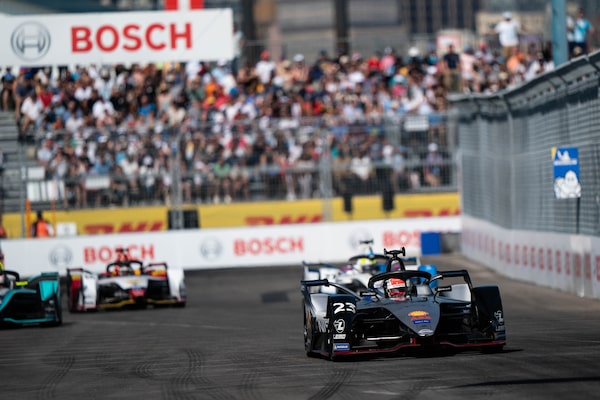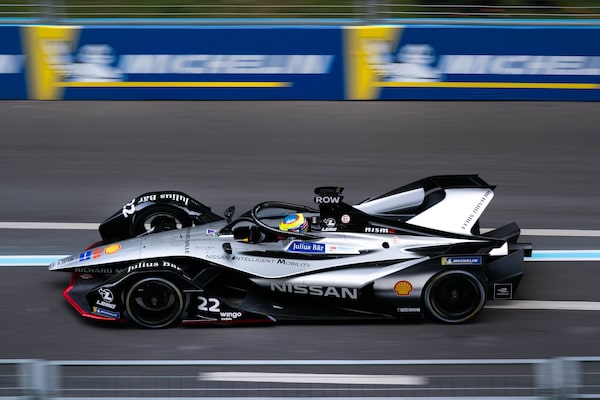
Electric race cars sprint around the Brooklyn Street Circuit during a Formula E race on July 14, 2019.Nissan/Handout
Last weekend, on the track at the Red Hook dockyards in Brooklyn, Formula E race cars were braking from 200 km/h for the hairpin turn near the stands. Just outside, perhaps 100 metres away, a Nissan Leaf braked for the traffic lights. They were using the same software, with the same newly-developed lines of code, to regenerate power from their brakes and engines in order to travel farther on their batteries’ charge.
“We all know how to build a powertrain” – the motor and gears that drive the cars – “but what we’re finding out at the race track is really, how far can we push the technology to get the maximum efficiency out of our systems?” says Michael Carcamo, director of motorsport for Nissan.
Racing can help engineers develop better real world production vehicles, which is why many car makers participate in Formula E, the electric version of Formula One. The same association sanctions both, though Formula E has an additional benefit beyond the exciting racing.
“We’ve always focused on the hardware, but I would say there’s an equal amount of importance on the software side,” Carcamo says. “And what we learn there is something that’s immediately translatable into a road car. Issues around range anxiety and all those other things can be stress-tested here first. Motorsports is the only avenue to do that in such a short time frame.”

As of this season, Formula E cars have batteries capable of completing a 45-minute race.Nissan/Handout
Right from the beginning, based on the technology already used in production electric vehicles, the cars were quick but unable to last long on their batteries’ charge. To have a 45-minute race, drivers needed a second, fully-charged battery. It was quickest to pull into the pits and jump into a second car that was ready to go, but this was a clear indicator of the limits of battery technology.
After all, if you think it’s bad to run out of power, or gas, on the highway, it’s infinitely worse to do so on a racetrack. Range anxiety is very real. Just ask Toyota, whose car ran out of fuel on the final lap while leading the 24 Hours of Le Mans in 2016. Engineers do everything possible to prevent this, and their creative solutions find their way very quickly into road-going cars – like for example, the lines of code that have already made their way into the Nissan Leaf. Successions of tweaks and improvements have since lead to new methods for converting the battery’s power from DC to AC and improved cooling.
In Formula E racing, the science of winning relies on using every bit of power available in the battery with nothing left in reserve at the end. If a car crosses the finish line with enough power to complete another lap, that’s just a waste of power that could have been used earlier. All the vehicles have identical batteries, however, supplied by McLaren, and so the difference is found in innovative ways to create regenerative power.
Originally, all the cars were identical and teams were not allowed to make any changes to them; it was purely a showcase for electric technology. In the second year, teams were allowed to develop some of their own components, including the electric motor, the inverter and the cooling system. In later seasons, the rules loosened to allow changes to the suspension, brakes and software.
This year, in its fifth season, the circuit finally got new batteries capable of completing a full 45-minute race – no need for an embarrassing second car. The cars are fitted with more powerful 250 kW motors, the equivalent of about 335 horsepower, and they can hit 280 km/h on a long enough straight. Off the lights, they’re at 100 km/h in less than three seconds.
“Eighty per cent of the car, we provide – it’s covered. This allows (the teams) to play with 20 per cent of the car,” says Alejandro Agag, Formula E’s CEO and the founder of the series.

Nissan e.dams driver Oliver Rowland practices at the #SwissEPrix in Bern.Nissan/Handout
“We do not allow them to work on aerodynamics, because you don’t get anything from making a super-aerodynamic Formula car into a road car. But if you can make a much more efficient electric motor and develop better software to manage the distribution of the energy from the battery to the powertrain, that you can use on electric mobility for everyone.”
The main difference is the sound. The cars’ motors make a loud whine, but you hear the tires screaming on the asphalt, not the deafening engines. Earplugs are not needed. The drivers say they can hear the crowd cheering as they pass at speed.
“Fans want to see good racing, and so far this season, with eight different winners, it’s been very unpredictable,” says Sebastien Buemi, Nissan’s lead driver. “People like the close racing, the fighting, the rubbing. It’s very cool.”
Actually, nine different winners. Buemi won the race at Red Hook, his first of the season. “I can well see that in five years, I’ll still be in Formula E,” he said. “This is the future of racing.”

Nissan has scored its first Formula E electric street racing championship victory with Sebastien Buemi taking a 'lights-to-flag' win in the New York E-Prix today.Nissan/Handout
Shopping for a new car? Check out the new Globe Drive Build and Price Tool to see the latest discounts, rebates and rates on new cars, trucks and SUVs. Click here to get your price.
Stay on top of all our Drive stories. We have a Drive newsletter covering car reviews, innovative new cars and the ups and downs of everyday driving. Sign up for the weekly Drive newsletter, delivered to your inbox for free. Follow us on Instagram,@globedrive.